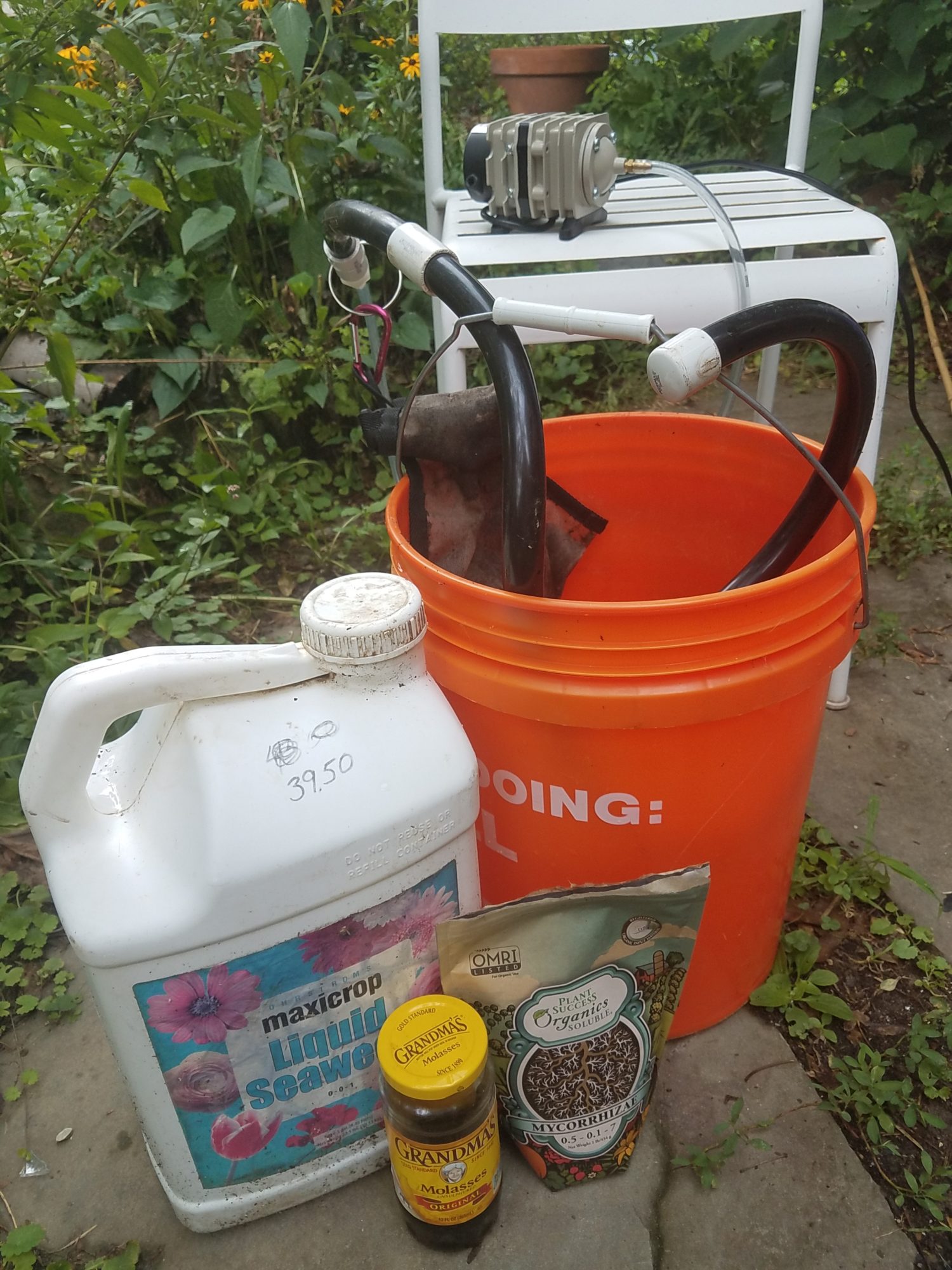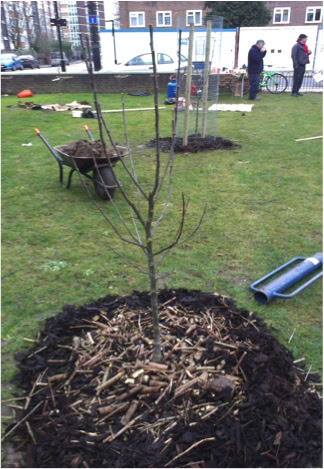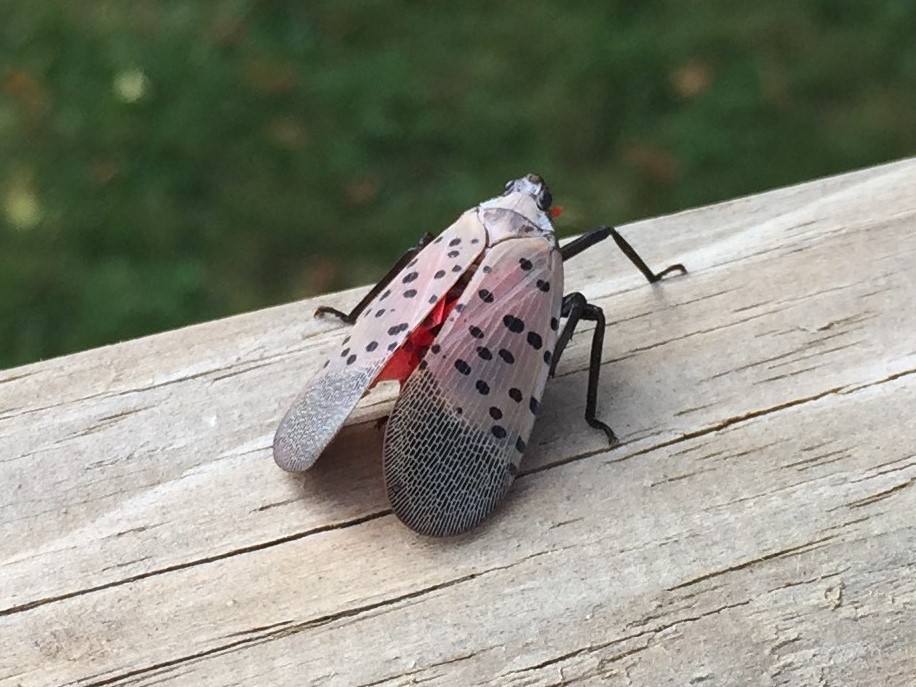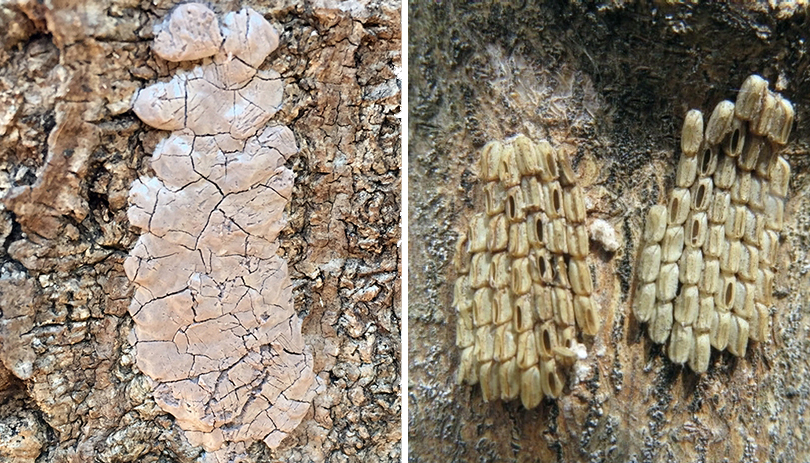In what is sure to be a challenging month for all, April is a key time for orchard care and efforts now will help ensure much-needed harvests later in the year. With our early spring, many fruit trees have already flowered and some are beginning to leaf out.
Please check out our new POP Monthly Orchard Task List for recommended maintenance activities to complete this month (and the entire calendar year). Here are some of the most vital tasks outlined in more detail
Spring Orchard Sprays
Apply holistic orchard sprays. Holistic sprays are composed of compost tea, liquid fish/seaweed, neem oil, and/or effective microbes. For best tree health and resistance to disease, apply up to 4 times in the spring (after bud break, at first pink of flowers, after petal fall, and two weeks after petal fall).

Depending on specific pest or disease problems, some orchardists might also consider other organic sprays including the ones listed below. In particular, plants that have suffered severe crop loss from fungal diseases (like brown rot, mildew, or scab) may be candidates for early spring sulfur or copper spray. This is best applied shortly before or after bloom, so the time is now if you want to do this.
Check out POP’s guides to orchard applications of:
• Compost Tea Sprays for Orchards
• Neem Oil Sprays
• Kaolin Clay Sprays
• Sulfur Sprays and Early Spring Management Techniques
• Pyrethrin Orchard Sprays
• Bt: Bacillus thuringiensis Orchard Spray
• Spinosad Orchard Sprays
Spring Orchard Planting
It is safe to plant new orchard plants as soon as the ground can be worked. POP’s preferred spring planting period is between the beginning of April and mid-May, so plants have some time to get established before the heat of summer hits. Remember that fall is also great for planting most orchard plants, and fall plantings actually have better survival rates!
POP and TreePhilly are collaborating on a free fruit tree giveaway this spring, with delivery to your door in May! There are still some trees available, including serviceberries, European pears, American plums, and mulberries:
POP TreePhilly Yard Tree Registration Form
POP is also holding a Plant Sale and Open House event at our new orchard and nursery space at The Woodlands on May 22.
Spring Weeding and Compost/Mulch Application
Yes, spring weeds are already popping up, and never too early to get ahead of them! It is also a good time to trim back any dead herbaceous material from companion plantings of flowers, herbs, and so on.
Building healthy soil is key to supporting trees’ health, resilience, and yields. Weed around the base of trees, and spread at least one or two inches of chipped winter prunings, shredded leaves, and/or mulch or compost in the early spring. Check out POP’s guide to Ramial Wood Chips and Weeding in Place.

Early Spring and Emergency Pruning
While optimal dormant pruning season is now behind us, those of you who waited on your peach trees should prune them now (peaches are the only fruit tree typically pruned during or immediately following flowering). For all other trees, most pruning should be limited to emergency pruning only!
Keep an eye out for any diseased, damaged, or dead wood that should be pruned away no matter the season. Pay special attention to the base of trees – especially of the stone fruit varieties: apricots, peaches, plums, nectarines – and prune away root suckers. These are quick upright growths that can be a cover for dreaded borers, which make a home beneath trunk wood.
Remember: use sharp, rust-free hand tools and sanitize between trees at the very least, and between every cut if the tree you’re tending has had previous conditions. For easy disinfecting, we recommend carrying a spray bottle with you of rubbing (isopropyl) alcohol or a bleach solution (1 part bleach: 10 parts water) to wipe down tools.
Pest and Disease Monitoring & Identification
Spring is when many pest and disease challenges show their first signs! Observe orchards regularly throughout the year for pest and disease problems, identify and respond appropriately. We’ve begun distributing physical copies to community partners, but in the meantime, you can check out our POP’s Scouting Guides for pest and disease management available for download on POP’s website.
These guides are intended to help properly identify the insect pests and diseases that affect the following common fruit trees:
• Apples
• Peaches
• Cherries
• Plums & Apricots
• Pears & Asian Pears
These guides include lots of photos and a description of how to identify the particular pest or disease and the damage caused by it. Proper identification is essential to treating these problems, as each has its own unique options for management! Once you have identified a pest or disease, you can then consult our website for management recommendations by using our search function.
Unwrap Figs and Pomegranates
It is safe to remove winter protection on these tender plants if you haven’t already done so.
Brown Rot
This fungal disease has caused some major crop loss to stone fruits in many city orchards. Easy to identify from the fuzzy and mummified fruit it leaves behind. Read POP’s full article on brown rot here.

April is critical for brown rot control: Although dormant pruning season is over, this is still a good time to prune peach trees if you haven’t got around to it yet! Unlike other fruit trees, peaches are best pruned during or right after bloom. Complete proper pruning to open them to more air and light. Prune out any brown rot canker from branch tips.
Now is the time for sulfur or copper sprays for control of brown rot, timed right after bloom is complete. Although organic, these sprays are very harsh so only recommended in cases of serious crop loss.
Holistic sprays can help boost overall plant health and resilience to diseases like brown rot. Holistic sprays are composed of compost tea, liquid fish/seaweed, neem oil, and/or effective microbes. For best tree health and resistance to disease, apply up to 4 times in the spring (after bud break, at first pink of flowers, after petal fall, and two weeks after petal fall).
Oriental Fruit Moth (OFM)
This moth has similarly damaged crops of stone fruits in many city orchards. Easily identifiable from the clear gummy castings from fruit and flagging branch tips. Read POP’s full article on OFM here.

Although Oriental Fruit Moths don’t generally emerge until May, it is possible to reduce OFM populations through control of their overwintering larvae in March or early April. Cultivate the soil underneath affected fruit trees to a depth of 4″ to kill overwintering larvae. Additionally, let chickens or other poultry do the work for you! Allowing chickens into the orchard understory for a week or two in March or early April can dramatically reduce populations of OFM, codling moth, and other pests that overwinter in the soil.
Keep your eye out for the first generation of OFM, which attacks branch tips, causing dieback called flagging! Prune out any branch tip flags and kill the larvae inside.
If OFM was a big problem last year, you might consider ordering some pheromone traps from places like: here and here. Another option for those with severe OFM problems is to order some BT spray to apply later in the season, available here.
Spotted Lanternfly (SLF)

We don’t yet know how much of a problem SLF will be for city orchards, but we can expect populations of this easy to identify new pest to explode and they are known to do damage to grapes, peaches, and many other fruiting plants. Read POP’s full article here.
In April, help reduce SLF populations. Scrape off and destroy Spotted Lanternfly egg sacks on trunks and really any other hard surfaces. Get them before they hatch! Also, consider installing sticky bands to capture nymphs and adults after they emerge. You can find them available for purchase here.

We’ll see when they emerge this year, but squash or spray pyrethrin on any nymphs or adults you see.

Finally, please give us a heads up when you first see Spotted Lanternfly or Oriental Fruit Moth in your orchards.
Happy April!
This POP Blog Post was written by POP Co-Executive Director Phil Forsyth, and re-edited for blog posting by POP Intern Joe Dizenhuz
SUPPORT US! If you found this entry useful, informative, or inspiring, please consider a donation of any size to help POP in planting and supporting community orchards in Philadelphia: phillyorchards.org/donate.